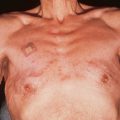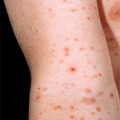Chapter 56 Retinoids
| TOPICAL PREPARATIONS | ORAL PREPARATIONS |
|---|---|
| Tretinoin (all-trans retinoic acid) Retin-A (0.025%, 0.05%, 0.1% cream; 0.025% gel; 0.05% liquid) Retin-A Micro (0.04%, 0.1% gel microsphere) Renova (0.02%, 0.05% emollient cream) Avita (0.025% cream and gel) Atralin (0.05% gel) Refissa (0.05% cream) Tazarotene Avage (0.1% cream) Tazorac (0.05%, 0.1% gel) Alitretinoin (9-cis-retinoic acid) Panretin (0.1% gel) Adapalene (retinoid-like drug) Differin (0.1% gel, solution, cream, pledgets) Epiduo (also contains benzoyl peroxide) |
Isotretinoin (13-cis-retinoic acid) Multiple brands (10-, 20-, 30-, and 40-mg capsules) Acitretin Soriatane (10- and 25-mg capsules) Bexarotene Targretin (75-mg capsules) |
Generic drugs appear as bold terms in the list.
Table 56-2. Therapeutic Applications of Topical Tretinoin
| FDA-APPROVED INDICATIONS | SELECTED NONAPPROVED APPLICATIONS |
|---|---|
Kockaert M, Neumann M: Systemic and topical drugs for aging skin, J Drugs Dermatol 2:435–441, 2003.
Yamauchi PS, Rizk D, Lowe NJ: Retinoid therapy for psoriasis, Dermatol Clin 22:467–476, 2004.
| FDA-APPROVED INDICATIONS | SELECTED NONAPPROVED APPLICATIONS |
|---|---|
| ACUTE ADVERSE REACTIONS | CHRONIC ADVERSE REACTIONS |
|---|---|
| Mucocutaneous Alopecia (<10%) Cheilitis (>90%) Dermatitis (50%) Pruritus (<20%) Pyogenic granuloma-like lesions in acne vulgaris (rare) Xerosis (>50%) Laboratory Elevated liver function tests (<10%) Hyperlipidemia (25%) Leukopenia (<10%) Systemic Arthralgias (16%) Impaired night vision Mental depression (uncommon) Pancreatitis (rare) Pseudotumor cerebri (rare) Spontaneous abortion Teratogenicity (cardiac, head and neck, CNS) |
Mucocutaneous Alopecia, persistent (rare) Dry eyes (rare) Systemic Osteoporosis Premature epiphyseal closure Skeletal hyperostosis |
Acitretin is FDA-approved only for the treatment of severe recalcitrant psoriasis. It is especially effective for pustular and erythrodermic psoriasis. It is often used as monotherapy in these variants but also may be used in conjunction with other forms of therapy such as psoralen plus ultraviolet light, type A (PUVA) in plaque-type psoriasis. Like isotretinoin, acitretin has been used in many other cutaneous diseases (Table 56-5).
| FDA-APPROVED INDICATION | SELECTED NONAPPROVED APPLICATIONS |
|---|---|
| Severe recalcitrant psoriasis | Granuloma annulare, generalized Ichthyoses (e.g., ichthyosis vulgaris) Keratosis follicularis (Darier’s disease) Mycosis fungoides (cutaneous T-cell lymphoma) Palmar/plantar pustulosis Pityriasis rubra pilaris Porokeratosis Subcorneal pustular dermatosis |
Key Points: Retinoids







